The only homemade Caesar salad recipe you need is made with a delicious dressing made from scratch using only a few ingredients. The homemade croutons take this salad to a whole new level!
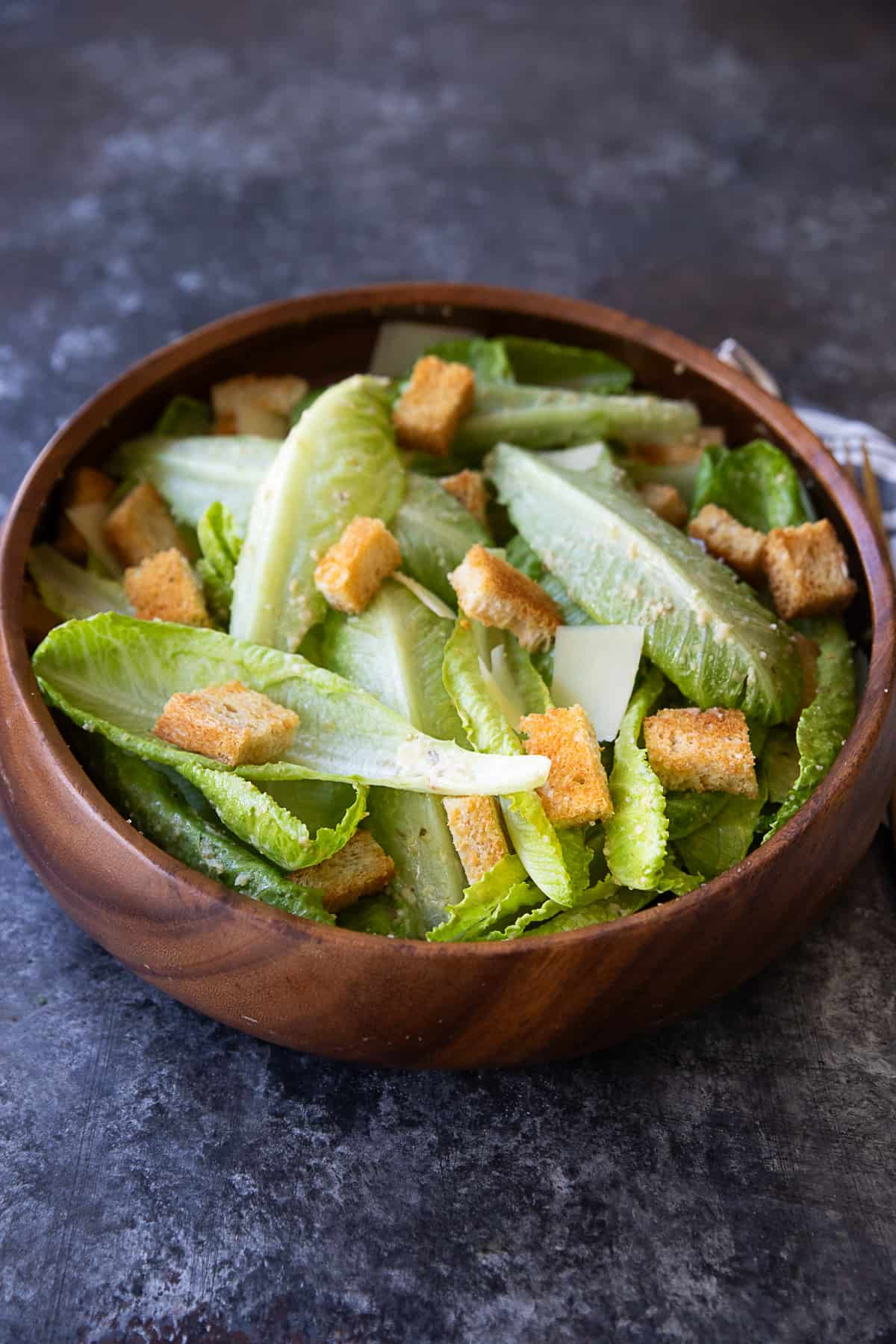
If you like fresh salads and homemade dressing as much as I do, you're going to love this Caesar salad. Just like my green goddess salad and caprese salad, this salad is made with simple ingredients and taste phenomenal. Let's dive in!
Table Of Contents:
Recipe Highlights
Cultural Influence: Italian Cuisine
Primary Cooking Technique: Baking; Wooden Bowl Preparation
Suitable for: Vegetarian (with anchovy substitute)
Not Suitable for: Gluten-Free or Vegan Diets
Dominant Flavor Profile: Bold Umami, Balanced with Zesty Citrus Notes
Skill Level Required: Intermediate-Level Kitchen Confidence

Ingredients for Homemade Caesar Salad
- Sourdough Bread: For extra flavor and texture, use sourdough bread for the croutons. It will crisp up beautifully in the oven and hold its shape better when tossed with the salad.
- Olive Oil: Use a high-quality extra virgin olive oil for both tossing the sourdough cubes and making the dressing.
- Anchovies: Anchovies provide the classic umami flavor in Caesar dressing. If you're not a fan of whole anchovies, you can substitute with anchovy paste or Worcestershire sauce for a similar depth of flavor.
- Garlic: Grating the garlic instead of mincing it ensures that it blends seamlessly into the dressing, infusing it with a subtle garlic flavor without any harsh bites.
- Capers: Capers add a briny, tangy kick to the dressing.
- Lemon: Freshly squeezed lemon juice brightens up the dressing with its tangy acidity. For maximum juice extraction, roll the lemon on the countertop before juicing, or use a citrus reamer to get every last drop.
- Egg Yolk: The egg yolk helps to emulsify the dressing, giving it a creamy texture. To reduce the risk of foodborne illness, use pasteurized eggs or substitute with store-bought mayonnaise if you prefer.
- Dijon Mustard: Dijon mustard adds a tangy flavor and helps to stabilize the emulsion in the dressing. Opt for a smooth Dijon mustard for a silky-smooth texture.
- Parmesan: Freshly grated Parmesan cheese adds a savory, salty kick to the dressing and the finished salad. For the best flavor, use high-quality Parmigiano-Reggiano cheese and grate it yourself.
- Romaine Lettuce: Use fresh, crisp romaine lettuce hearts for the base of the salad. To ensure maximum freshness, wash and dry the lettuce thoroughly before tearing or chopping it into bite-sized pieces.
Did You Know?
Caesar salad, a classic staple in many restaurant menus worldwide, has a fascinating history and several interesting tidbits associated with its origin.
Created in Tijuana, Mexico
Caesar salad was actually invented by an Italian immigrant named Caesar Cardini in Tijuana, Mexico, in the 1920s. Cardini owned a restaurant in Tijuana frequented by Americans during Prohibition, as alcohol was legal in Mexico. Legend has it that he created the salad spontaneously when he ran out of ingredients and had to improvise with what he had on hand.
Fourth of July
Another account suggests that Caesar Cardini created the salad on the Fourth of July weekend in 1924. They say that Cardini had a busy restaurant and was running low on supplies, so he put together a simple yet delicious salad using romaine lettuce, garlic, croutons, Parmesan cheese, olive oil, raw egg, Worcestershire sauce, and lemon juice.

Original Recipe Simplicity
The original Caesar salad recipe was much simpler than modern versions. It typically included romaine lettuce leaves, croutons, Parmesan cheese, olive oil, raw egg, Worcestershire sauce, lemon juice, and black pepper. Anchovies were sometimes used in the dressing, but they were not a standard ingredient in the original recipe.
Tableside Preparation
In the early days, Caesar salad was often prepared tableside by waiters, who would toss the ingredients together in a large wooden bowl and assemble the salad in front of diners. This interactive presentation added to the salad's appeal and popularity.
Popularity Surge
The Caesar salad gained widespread popularity in the United States during the mid-20th century and became a favorite among Hollywood celebrities and prominent figures. Its popularity was further boosted by its inclusion on the menus of renowned restaurants and hotels across the country.
National Caesar Salad Day
In the United States, National Caesar Salad Day is celebrated annually on July 4th, commemorating the salad's creation and its association with Independence Day festivities.
Homemade Croutons: The Crunch to Your Salad
Creating homemade croutons for your Caesar salad adds a textural crunch and depth of flavor to this classic dish. Here are some tips, hacks, and variations for making the perfect croutons.
Bread Selection
Use day-old sourdough bread or French baguette for the best texture and flavor. You can also use thick toast if sourdough or baguettes aren't readily available.
Stale bread works well for croutons as it crisps up nicely in the oven without becoming overly dry.
Uniform Cubes
Cut the bread into uniform cubes to ensure even baking. Aim for cubes that are around 1 inch in size for the perfect bite.

Seasoning Options
Experiment with different seasonings to customize your croutons. Toss the bread cubes with olive oil, garlic powder, Italian seasoning, or paprika. Sprinkle grated Parmesan cheese before baking for enhanced flavor.
Even Coating
To ensure that the seasonings are evenly distributed, toss the bread cubes with olive oil and seasonings in a large bowl until they are well coated. This ensures that every crouton is covered with flavor.

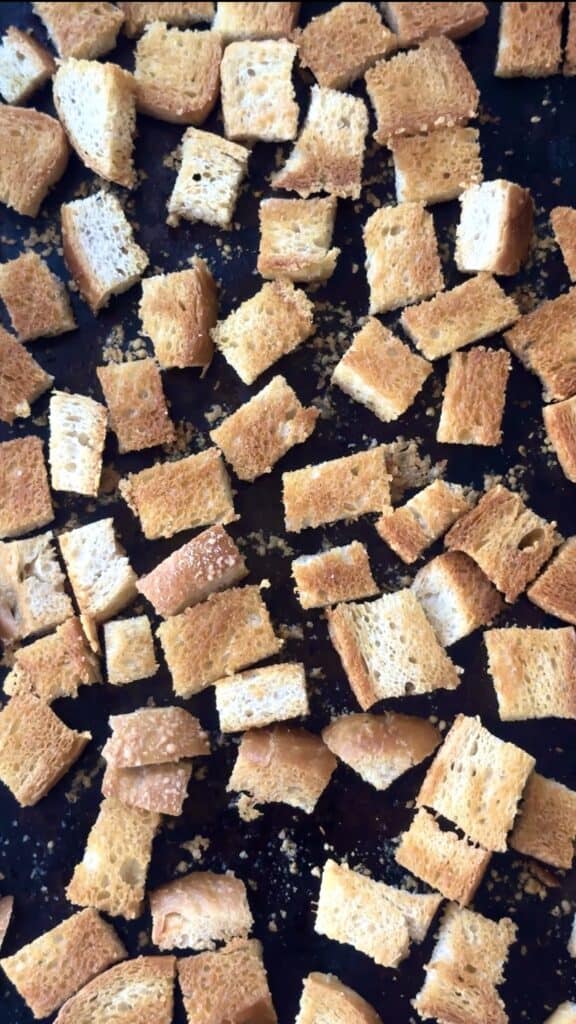
Baking Method
Spread the seasoned bread cubes in a single layer on a baking sheet to ensure that they crisp up evenly. Bake in a preheated oven at 375°F (190°C) for 15 to 20 minutes, or until the croutons are golden brown and crisp, stirring/flipping occasionally for even browning.
Bringing the Caesar Dressing Together
The Caesar dressing is the heart and soul a classic Caesar salad. Mastering its creation is key to achieving a truly memorable dish.
Step 1: Anchovies and Capers
Begin by mashing the anchovies. Next, mash anchovies with grated garlic and capers in a wooden bowl. This step infuses the dressing with a rich umami depth and savory complexity. Alternatively, finely chop these ingredients if preferred. Also, add the capers.


Step 2: Egg yolk, mustard and olive oil
Incorporate egg yolk and Dijon mustard into the mixture. These ingredients act as emulsifiers, helping to bind the oil and lemon juice together and create a creamy, luscious texture. Use an immersion blender if preferred for effortless emulsification.
Then, slowly drizzle in olive oil while whisking continuously or blending, allowing the oil to emulsify with the other ingredients and create a smooth, creamy dressing.
Add freshly squeezed lemon juice to the mixture. The acidity of the lemon brightens the flavors of the dressing.


Step 3: Parmesan
Stir in grated Parmesan cheese to infuse the dressing with its signature salty, nutty flavor. This adds depth and richness to the dressing, enhancing its overall complexity.
Season the dressing with a touch of black pepper to add a subtle hint of warmth and spice. Taste and adjust the seasoning as needed, adding more lemon juice, salt, or pepper to achieve the perfect balance of flavors.
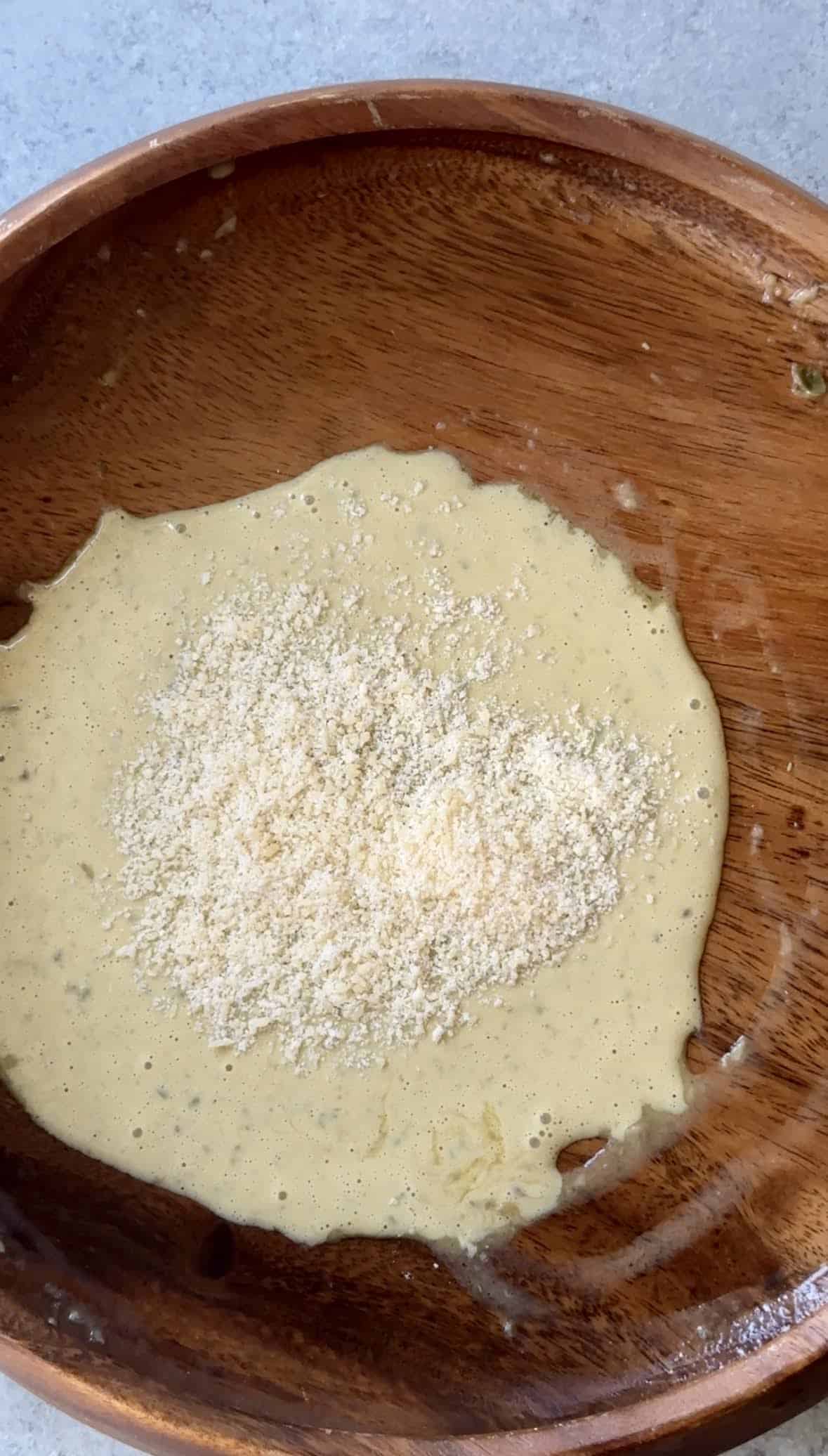
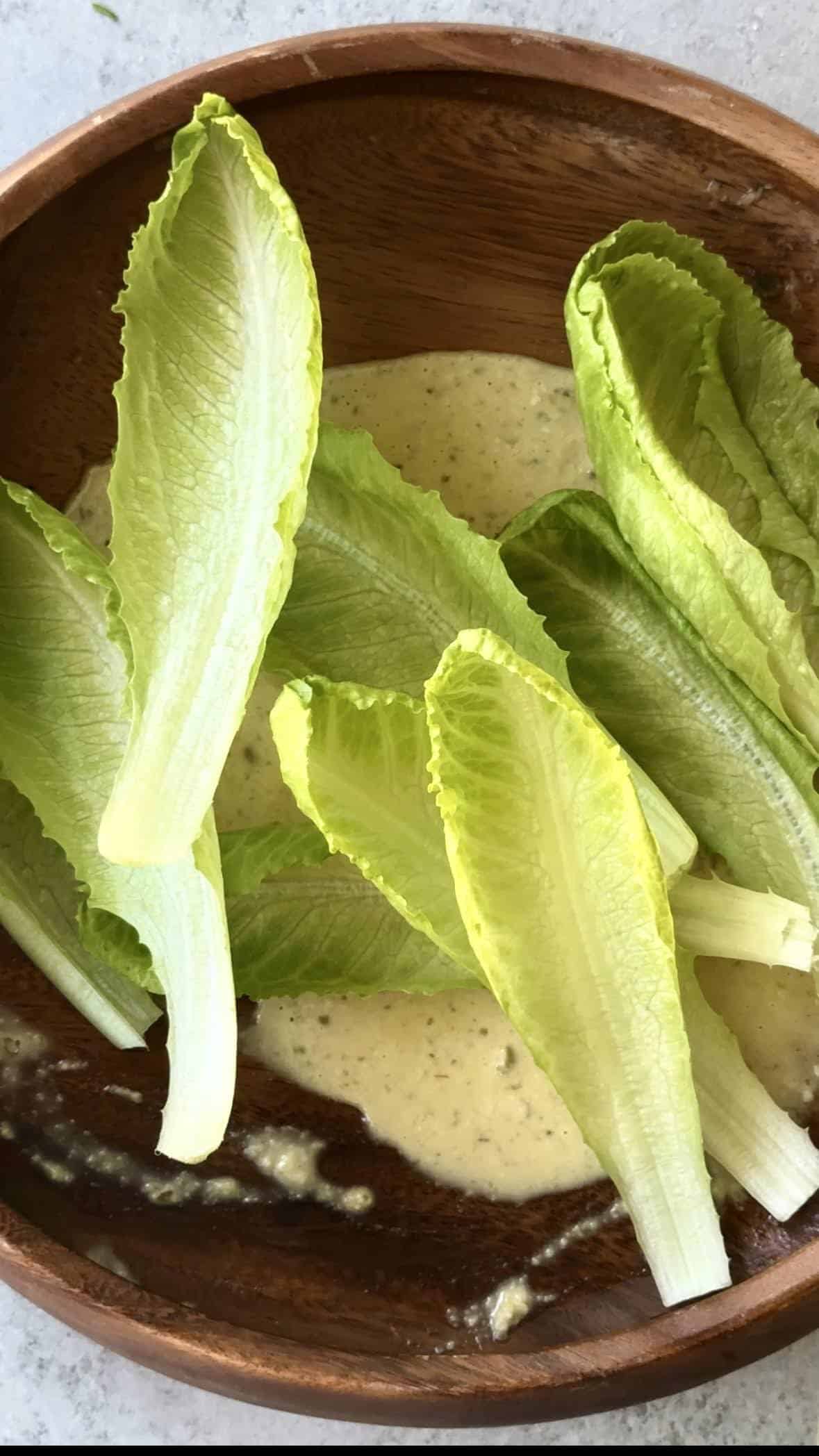
Step 4: Assemble
Then toss the romaine lettuce in the dressing before assembling the salad.
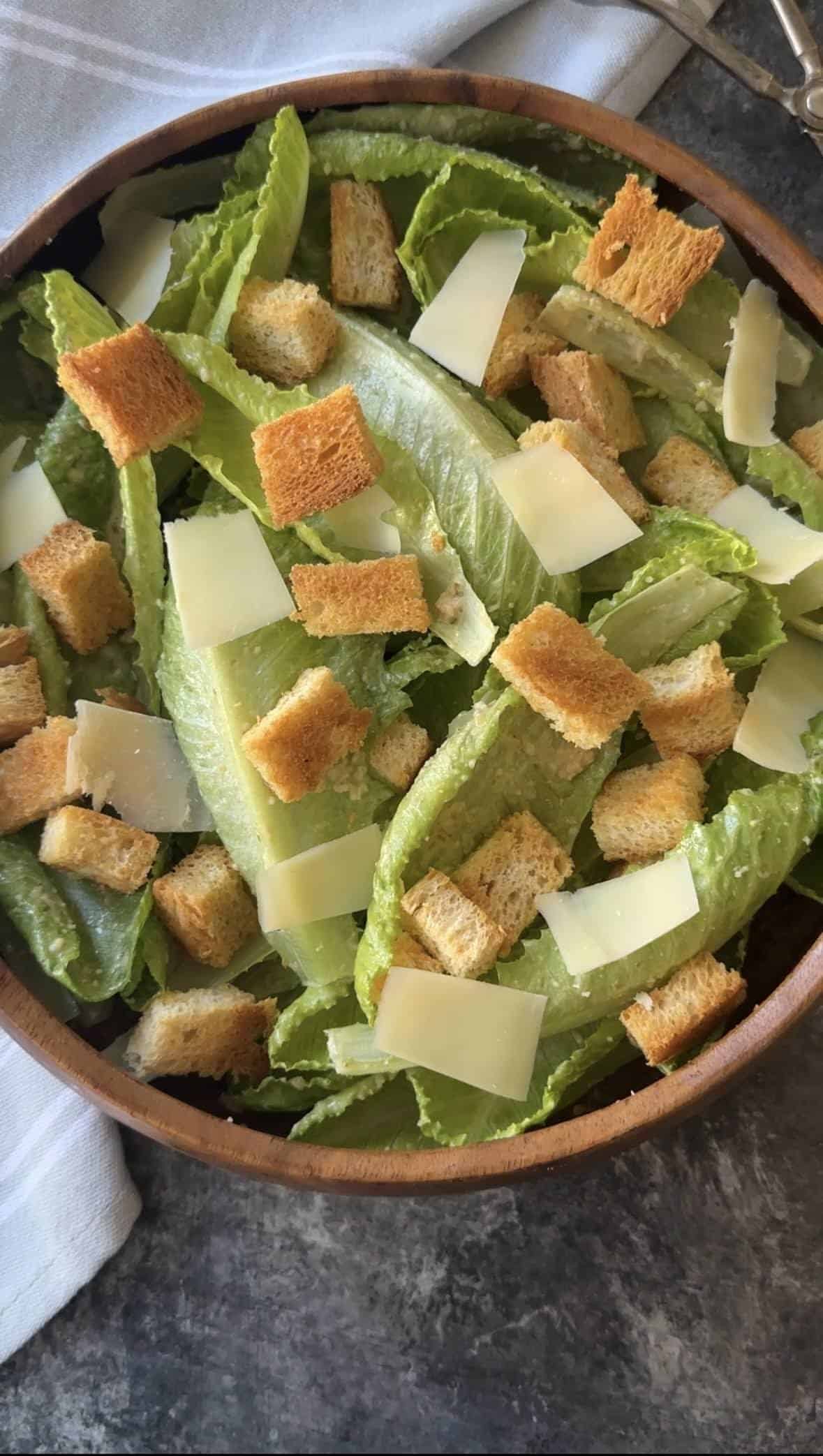
Tips, Tricks, and Hacks for Homemade Caesar Salad
Try rinsing the capers under cold water to remove some of the saltiness before adding them to the dressing.
- For a creamier dressing, use an immersion blender to achieve a smooth, velvety texture. This ensures that the ingredients are evenly blended and the dressing has a luxurious mouthfeel.
- Use fresh, crisp romaine lettuce hearts for the base of your Caesar salad. Avoid wilted or bruised leaves, as they can detract from the salad's texture and appearance.
- After washing the romaine lettuce, make sure to dry it thoroughly using a salad spinner or paper towels. Excess moisture on the leaves can dilute the dressing and make the salad soggy.
- Start by adding the lettuce to the dressing and toss well to coat. You can always add more dressing if needed, but it's difficult to remove excess dressing once it's been added.
- Include crunchy elements like homemade croutons, toasted nuts, or seeds to add texture and contrast to the salad. These crunchy components elevate the salad and make it more satisfying to eat.
- Grate fresh Parmesan cheese just before serving for the best flavor and texture. Pre-grated Parmesan cheese can lack freshness and may not melt as well into the salad.
- Caesar salad is best served immediately after tossing to prevent the lettuce from wilting and the croutons from becoming soggy. If you need to prepare the salad in advance, keep the dressing and croutons separate until ready to serve.
Variations and Substitutes
Croutons
Variations: Get creative with your croutons by experimenting with different bread varieties and seasonings. Try using whole grain bread, rye bread, or even gluten-free bread for a different texture. You can also add fresh herbs like rosemary or thyme for a fragrant twist.
Crouton Alternatives: If you prefer a gluten-free option or want to switch things up, consider using roasted chickpeas or toasted nuts as a crunchy topping for your Caesar salad instead of traditional croutons.
Season the chickpeas with olive oil, garlic powder, and smoked paprika before roasting for a crunchy and flavorful alternative.
Dressing
The main flavor of the Caesar salad is in the dressing so it’s important to make the dressing properly.
You can use an immersion blender because a standard blender won’t work as well. If you’re not using an immersion blender, if you’re whisking it by hand, like I have with a fork, it’s important to add the olive oil very slowly so the mixture emulsifies.
Toss the romaine lettuce with the dressing just before serving to ensure maximum freshness and flavor.
For a lighter option, consider reducing the amount of oil and cheese in the traditional recipe.
Make a vegan-friendly Caesar dressing by omitting the egg yolk and anchovies. Instead, use ingredients like vegan mayonnaise, Dijon mustard, and nutritional yeast to achieve a creamy, umami-rich dressing without eggs.

Storage
Crouton Storage: Homemade croutons can be stored in an airtight container at room temperature for up to one week. If they start to lose their crispness, simply reheat them in the oven for a few minutes before serving to revive their crunch.
Storage and serving for Caesar dressing: Transfer the Caesar dressing to a jar or container and refrigerate until ready to use. Give it a good shake or stir before serving to re-emulsify any separated ingredients.
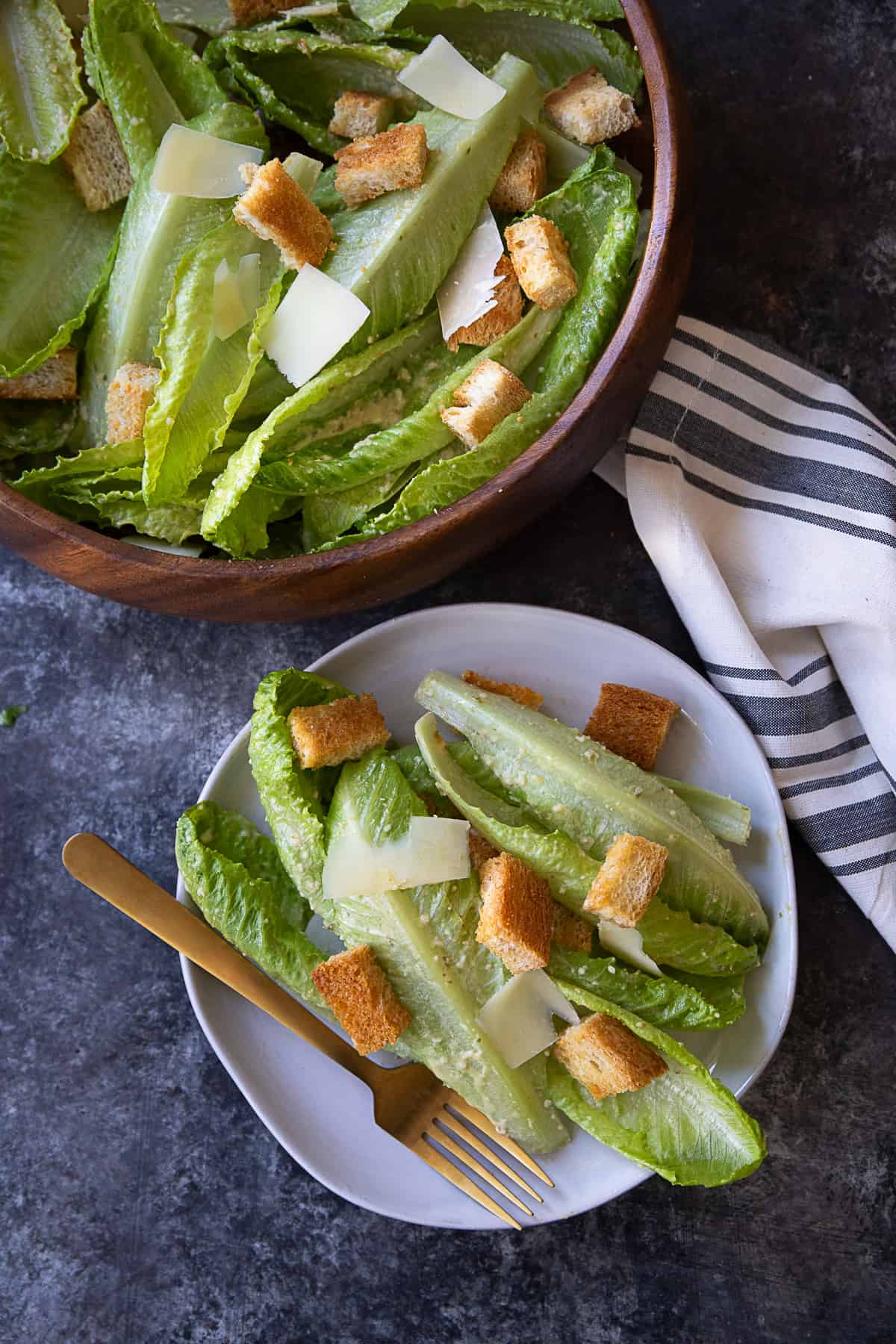
Frequently Asked Questions
The original recipe did not include anchovies; they were added later by chefs looking to enhance the flavors.
Yes, there are variations that use mayonnaise or other substitutes to avoid raw eggs.
Romaine lettuce is the traditional choice for its crunch and flavor.
Parmesan cheese is commonly used, either shredded or in flakes.
Some variations include adding protein like chicken or shrimp, or using different greens.
Other Great Summer Salads to Try
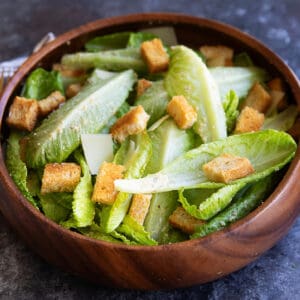
Homemade Caesar Salad (Simplified)
Ingredients
Croutons
- 4 slices Sourdough bread
- 2 tablespoon Olive oil
Dressing
- 4 Anchovies
- 1 clove Garlic grated
- 1 teaspoon Capers
- 1 Lemon juiced
- 1 Egg yolk
- 1 teaspoon Dijon mustard
- ¼ cup olive oil
- ½ cup Parmesan grated
- Salt and Pepper to taste
Salad
- 1 head Romaine lettuce
Instructions
Croutons
- Preheat the oven to 375 degrees F.
- Cut the sourdough bread into 1-inch cubes. and toss the sourdough pieces with the olive oil.
- Spread in one single layer on the baking sheet and bake for 15 to 20 minutes, stirring a couple of times so they're crispy on all sides.
Dressing
- Place the anchovies with garlic and capers in a wooden bowl and mash using a fork. You can also finely chop everything.
- Add in the lemon juice, egg yolk, and Dijon mustard. Mix and make sure it is all well combined.
- Add in the olive oil and mix until creamy and emulsified. You can use an immersion blender if preferred.
- Stir in the grated parmesan. Toss the romaine lettuce in the dressing and top with the croutons.






Denise
How much olive oil for the dressing? I only see the 2 T for the croutons…
Shadi HasanzadeNemati
Sorry for the confusion, I fixed it 🙂 1/4 cup 🙂
Boston Girl Bakes
This Caesar Salad is perfection! It boasts a fresh and delicious flavor combination that shines on its own as a dinner or a side dish. And let's talk about that dressing—it's absolutely out of this world! I'll be making this again for sure, thank you!
Paula
I love caesar salad in restaurants, so I'm really excited to try this at home! Thanks for the helpful recipe.
Jacqueline
Sounds good to me with extra parmesan. Yum!
TAYLER ROSS
This is my new go to caesar recipe! So delicious and fresh tasting!
Eva @MediterraneanSavor
Sounds delicious. Love the combo of capers and anchovies in the dressing!